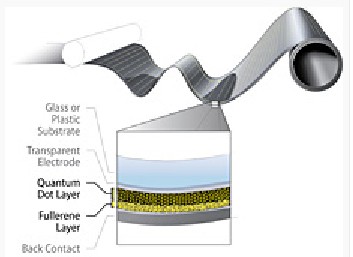Aug
29
Cutting Photovoltaic Solar Cell Cost By 75%
August 29, 2012 | 3 Comments
RTI’s solar cells are formed from solutions of semiconductor particles, known as “colloidal quantum dots” that can have a power conversion efficiency competitive to traditional cells at a fraction of the cost.

Solar Cell Built With Colloidal Quantum Dots. Cross-sectional drawing of RTI’s QD-photovoltaic architecture, as it could be applied to a roll-to-roll manufacturing process. Image Credit: RTI International.
Colloidal quantum dots are inorganic semiconductors that are synthesized and processed in solution and combine the advantages of organic materials with those of inorganic semiconductors. They differ from conventional traditional bulk inorganic semiconductors in that colloidal quantum dots have tunable optical and electronic properties owing to the quantum size effect. Other uses that RTI has experience in include visible and infrared photodiodes, photovoltaic cells, and photosensor arrays.
RTI and others are focused on solar cells due to the costs driving the technology out of competitiveness. Yet the lure of free energy remains. Solar energy has the potential to be a renewable, carbon-neutral source of electricity, endlessly replenishing itself each day.
The RTI developed solar cells were created using low-cost materials and processing techniques that reduce the primary costs of photovoltaic production, including materials, capital infrastructure and energy associated with manufacturing.
The preliminary analysis of the material costs of the technology show that it can be produced for less than $20 per square meter, which can be as much as 75% less than traditional solar cells.
Ethan Klem, a research scientist at RTI and co-principal investigator of the project said in the Institute’s press release, “Solar energy currently represents less than 1 percent of 1 percent of the global energy supply, and substantial reductions in material and production costs of photovoltaics are necessary to increase the use of solar power. This technology addresses each of the major cost drivers of photovoltaics and could go a long way in helping achieve that goal.”
If the technology will scale it will be very welcome, indeed.
The press release is quite vague and the study paper is behind the pay wall, but details can be found published in Applied Physics Letters.
In demonstration tests, the cells consistently provided a power conversion efficiency above 5%, which is comparable to other emerging photovoltaic technologies.
There is good reason to expect the efficiency will improve.
Jay Lewis, a senior research scientist at RTI and the project’s other principal investigator points out, “The efficiency of these devices is primarily limited by the amount of sunlight that is absorbed. There are many well-known techniques to enhance absorption, which suggests that the performance can increase substantially.”
The cells, which are composed of lightweight, flexible layers, have the potential to be manufactured using high volume roll-to-roll processing and inexpensive coating processes, which reduces capital costs and increases production. Unlike traditional solar cells, the RTI-developed cells can be processed at room temperature, further reducing input energy requirements and cost.
In addition to being low-cost, the new cells have several other key benefits, including higher infrared sensitivity, which allows the cells to utilize more of the available solar spectrum for power generation.
For the past couple years its been easy to overlook photovoltaic due to the costs. Its clear now the cell developers have the foundation to build up a market. Still the mounting, installation and current management folks have to get it together as well. Without everyone involved in a photovoltaic install on board driving to lower costs, there simply won’t be very many – if any at all.
Comments
3 Comments so far


is that really true?
how confident ur at this test?
I was imagining a product like this the other day and there it is! Fantastic. Can I buy it already or maybe invest something in it’s production?
Hey this sounds awesome, can i invest in your project and or buy some for my electric car?